
The world is changing rapidly in this technological age. Children today need to be prepared for a very different future in which technologies such as digital fabrication (for example, 3D printing), robotics and artificial intelligence will be driving all kinds of changes to work and leisure.
One means of ensuring that children are prepared to be active citizens in this future is to provide them with relevant skills and knowledge, hence the need for more emphasis on science, technology, engineering and mathematics (STEM).
Helping settings to explore what a STEM approach might look like in the early years is the research project ‘Makerspaces in the Early Years: Enhancing Digital Literacy and Creativity’ (MakEY). Conducted in seven countries – Denmark, Finland Germany, Iceland, Norway, the UK and the USA – the project aimed to develop young children’s STEM knowledge and skills through hands-on tinkering and making within makerspaces.
WHAT ARE MAKERSPACES?
The Maker Movement has been popular in the USA and other countries for some years now. It is a grassroots movement based on the concept of DIY and provides people with access to spaces where they can tinker, make and hack, using a range of tools.
Such spaces may contain machines such as laser cutters and 3D printers, as well as coding resources, woodwork tools, electronic equipment and so on. In these spaces, people can design and make what they wish, and the spaces have been given names such as ‘makerspaces’, ‘hackspaces’ and ‘FabLabs’. Whatever the name, the emphasis is always on creativity and experimentation.
However, makerspaces do not need to have high-end equipment. They can be spaces in which individuals can design and make things using all kinds of materials. In that sense, nurseries and schools have always been makerspaces, offering children opportunities to create, using construction kits, art and craft materials, and so on. So, what is new?
The MakEY project focused on introducing new tools and skills (such as 3D printers and learning electronics) to well-established early years practices, with the aim of enabling children to acquire STEM skills and knowledge through familiar approaches that incorporated art and craft, storytelling and so on – also known as a STEAM approach (integrating STEM with the arts).
In the following case studies, we outline ways in which early years settings in Sheffield and Barnsley supported their ‘mini-makers’ through inspiring MakEY projects.
CASE STUDIES
Broomhall Nursery School, Sheffield
Given that the project took place just before Christmas, the topic of light and colour was chosen. The aim of the project was to introduce children to t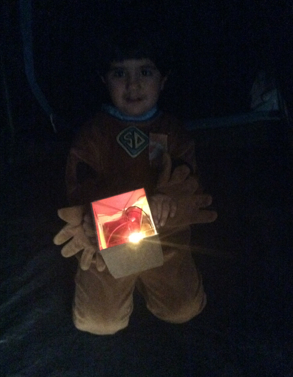 he concept of a circuit through a variety of activities that involved making simple circuits (an LED bulb connected to a battery pack).
he concept of a circuit through a variety of activities that involved making simple circuits (an LED bulb connected to a battery pack).
At the start of the project, children were invited to make a torch using a small battery pack with connectors, which enabled an LED bulb to be inserted into it. The children used Washi Tape to decorate their torches, then inserted the torch into a cardboard box with a plastic lid, which also contained coloured cellophane. The children loved their ‘light boxes’, which were taken into a black-out tent in order to explore their effects more fully.
The children used the (free) app Pablo to create digital lightshows. The app is very simple to use and involved the children waving their torch in the air as the camera in a smartphone captured the movement on screen. The resulting images were so delightful that the nursery staff decided to print them out and use them for the annual calendar, giving parents the opportunity to share this engaging work.
The children were involved in a range of other activities over the week, all of which reinforced learning on how to create a circuit. It is possible to create a circuit on paper, using copper tape, crocodile clips, batteries and battery packs and LED lights. The children enjoyed creating drawings that could then be made to light up.
Another activity which, like the drawing circuits, enabled electronics to be embedded in familiar early years practice, was ‘squishy circuits’. This involves the use of playdough, which is conductive. Children can add bulbs to models created in playdough, which light up when linked to batteries and battery packs.
Finally, children enjoyed making animated films using the app iMotion. They created patterns and pictures using transparent shapes placed on the screen of an OHP, then took a series of still images of the shapes projected on to the wall in order to create a simple but effective animation.
These and many other activities provided lots of opportunities for the children to learn about circuits, which is a topic normally introduced to older children. However, because the activities were introduced in ways that enabled children to play, experiment and build on established knowledge and skills, they were appealing and integrated science education effectively with art and crafts.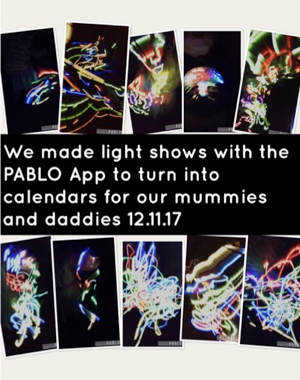
While the activities did create products, it is important that children have opportunities to tinker and experiment in makerspaces without pursuing a particular end. In this way, children can play with materials, finding out about their properties, and exploring imaginatively what the materials can do. If possible, if there is the space to store resources, it is also helpful if children can keep their creations and return to them over time, as these iterations can enable children to revisit concepts and extend their learning.
Monteney Nursery, Sheffield
This approach was also used successfully at Monteney Nursery, whose project coincided with Broomhall’s and shared the same aim of providing opportunities for children to learn about light and colour. Here, children were involved in making a model house at home with their parents, then creating lights for their houses, making street lights and, finally, constructing light-up Christmas trees for the model neighbourhoods.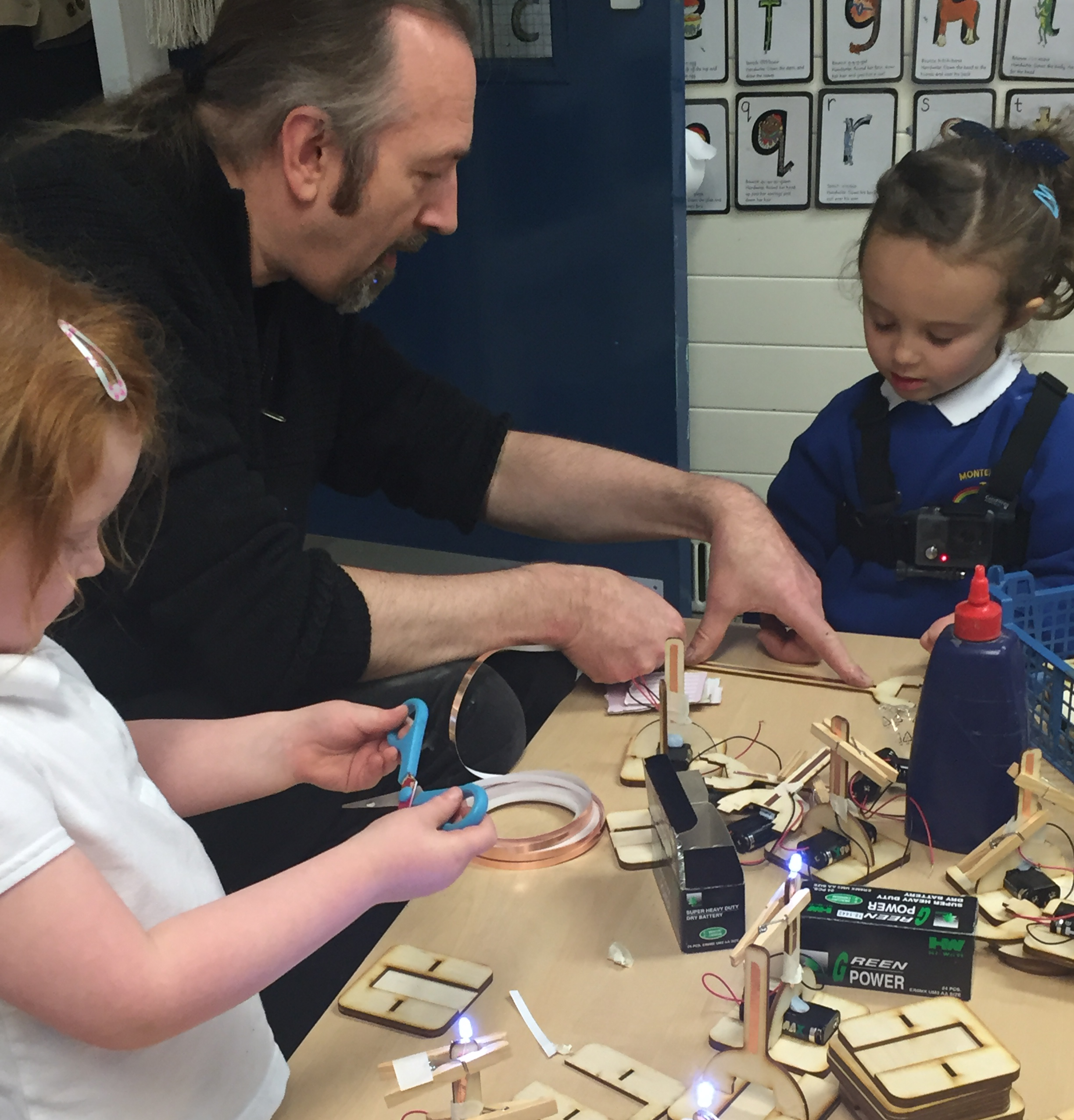
Nursery class teacher Alex Ardron developed some detailed instructions using photograph strips, which helped the children understand the process. They could also return to the instructions when they became stuck at any stage.
In this project, a link was made with a local makerspace, which had a laser cutter. James, the maker, visited the nursery and worked with the children to help them create the circuits for their models. Children created collages of Christmas trees using sticky paper triangles, and James then cut these shapes out of wood, using the laser cutter. The children attached colour-changing LEDs to their trees and created circuits using copper tape, batteries and battery packs.
Each of the children’s Christmas trees were distinctive and, placed together, they created a lovely forest of twinkling trees! The nursery decided the forest could provide a backdrop for films, using green screen technology. The children were filmed singing Christmas songs in front of a piece of green material, and a low-cost app – Green Screen by Do Ink – was then used to make the films. This involved positioning an image of the twinkling Christmas forest as a backdrop to the films of the children singing.
As was the case with Broomhall Nursery, these activities proved to be very popular with the children and led to important scientific and technology learning.
The staff at both nurseries were delighted with the projects. The head teacher at Broomhall Nursery, Diane Hetherington, noted the learning that occurred over the course of one week, which was extensive (see box, overleaf).
Ms Hetherington also felt that the project had been beneficial for children with particular needs, such as Henry. He was shy and the school had referred him to speech and language services as he was speaking little and was trying to learn four languages. ‘The MakEY project and those activities just captured his imagination,’ explains Ms Hetherington. ‘He was thrilled. I remember him making his lightbox, making his little sticker and putting it on the box, going in the dark den with Jackie and then saying, “Oh, Diana, come in, come in”, wanting to show me what he’d done.
‘Then, when it was group time, we talked about what the children had made and showed the other children who had not been involved, and he stood up and he told them about his light and his lightbox and the traffic lights that he’d made…red was for stop and blue was for the police and red was for the fire engine. So, all this language suddenly came bursting out of Henry that we’d not really heard before.
‘When his mum came at the end of the day, he was so excited to tell her [and] show his mum his little lightshow. So, we went into our sensory room and turned all the lights off and he showed his mum what he’d done. I talked to her about the Pablo app and she downloaded it instantly on her phone. She was saying that he actually talked to his grandfather in Lithuania on Skype and was really interested in electric and circuits, so she felt that it was just something that had captured his interest and that had actually helped his confidence.
‘He wasn’t around on day two, but day three he was there again, and he came in and it had been snowing, and he said, “Diana, in the garden, you’ve got snow.” Then I remember him going to the table and sitting down and saying, “What are we making today?” For me, that was just absolutely fantastic because he was ready and he wanted to see what we were making that day.’
For staff, the project involved learning new skills, such as green screen technology, and using squishy circuits. There are internet resources that offer guidance in engaging in these and other maker activities, and the MakEY website provides information for practitioners.
Monteney Nursery found it valuable to draw on the skills of a local maker – you could try to find out if there is a makerspace or Fab Lab near you and, if so, ask if anyone is interested in working with your setting to share their knowledge.
Thurlstone Primary School, Barnsley
The theme of the project in the Foundation Stage class at Thurlstone Primary School was ‘minibeasts’, while the aim was to introduce the children to a 3D printer.
Staff used a printer provided by Create Education along with the free 3D design app, Tinkercad, which enables users to draw objects that can then be printed on a 3D printer. Easy-to-follow online tutorials are available to guide users through the app.
With the practitioners’ support, the children drew their own 3D designs of minibeasts and were excited to see their designs coming to life on the 3D printer (below). The printed models were then used to cut out playdough shapes and to make printed pictures, as the children used paint and paper to create their unique prints.
As with the other settings, Thurlstone used both digital and non-digital resources in these activities. Gaining skills with new technologies does not mean that traditional skills and knowledge are overlooked; instead, learning is integrated across areas of learning.

SETTING UP A MAKERSPACE
STEAM activities, such as those outlined above, do not need a dedicated space. In the case of Broomhall and Monteney nurseries, all of the electronics and other maker equipment were placed on a trolley, which could then be wheeled to tables. However, some of the early years settings involved in the MakEY project have set up dedicated areas with a range of maker tools and resources.
There is no definitive list of materials and resources to provide in a makerspace as it depends on children’s interests and stage of development as well as what you would like to include in the area. However, settings with makerspaces have found the following resources useful: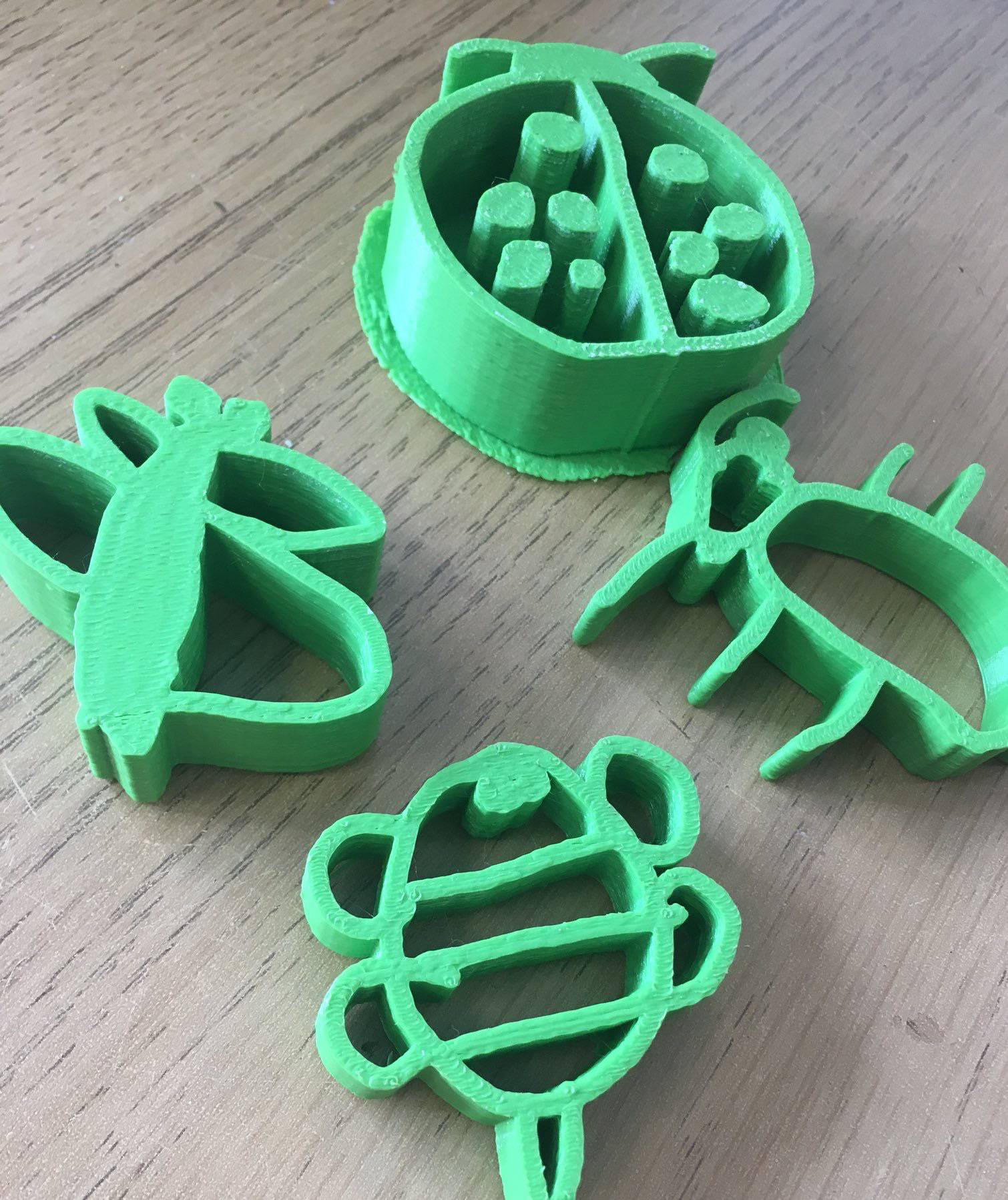
- cardboard
- MakeDo (tools to support construction with cardboard)
- art and craft materials – scissors, glue, foam shapes, paint, drawing tools, etc
- woodwork tools, pieces of wood, nails and safety goggles
- electronics equipment – LEDs, batteries, battery-holders and crocodile clips
- playdough
- copper tape
- paper cups
- Lego bricks
- wooden construction sets.
The following equipment is also useful to enable children to create films and animation:
- tablet/s
- tripod
- green screen and/or the insides of pizza boxes painted bright green
- lightbox (with transparent shapes, etc)
- play figures.
Further guidance is provided in the (free) booklet produced by the MakEY project team, Makerspaces in Early Years Settings and Schools: Guidance and Resources. It also includes information on relevant apps and resource companies.
Some of the early years settings in our studies have set up outdoor ‘tinker tables’ which offer additional opportunities for integrating natural objects into the maker process. It is worth noting that scrap materials can be used in makerspaces – ask parents or local businesses if they can donate unwanted resources.
CONCLUSION
The MakEY project was very successful in introducing early years settings to the concept of STEAM. Children responded with interest and excitement, and practitioners noted learning across a range of areas. This kind of approach is useful as it provides a meaningful context for STEM learning and thus attracts children who might otherwise be reluctant to engage with these areas of learning.
It has been identified that girls, working-class children and children from some black, Asian and minority ethnic communities are less likely to pursue STEM subjects in school, and thus providing an early and positive experience in this area could be beneficial in fostering long-term interest.
Given the changing nature of society and the need to ensure children are prepared for the challenges ahead, introducing makerspaces to early childhood settings can make a positive contribution, and can lead to new and exciting ways of engaging in STEM learning.
Jackie Marsh is professor of education at the University of Sheffield; Alex Ardron is nursery teacher at Monteney Primary School, Sheffield; Zoe Clayton is Foundation Stage leader and joint maths leader at Thurlstone Primary School, Barnsley; and Diane Hetherington is head teacher at Broomhall Nursery School, Sheffield
MakEY experiences: Broomhall Nursery School
Activities
In the main activities, the children:
- made small lightboxes, using boxes, acetate, bulbs, battery packs, batteries, crocodile clips and coloured cellophane
- created a lightshow by taking lightboxes into a dark den and making little GIF lightshow clips with the Pablo app
- used a mini printer to make stills of lightshows into stickers
- made decorations, using conductive and non-conductive playdough, shape cutters, LEDs, battery packs and batteries
- made a variety of drawings that lit up, using copper tape, LEDs, batteries, circuits, paper and pens and acetate
- made torches – using LEDs, battery packs, batteries and Washi Tape – then GIF lightshow clips using the torches and the Pablo app in the dark den
- made short movies with objects on the OHP using the iMotion app
- watched the iMotion movies and GIF clips on an interactive whiteboard, which was made into a cinema experience with popcorn
- made a disco in the whiteboard room with torches and danced to music
- wore bodycams to record themselves during the various activities.
Cross-curricular learning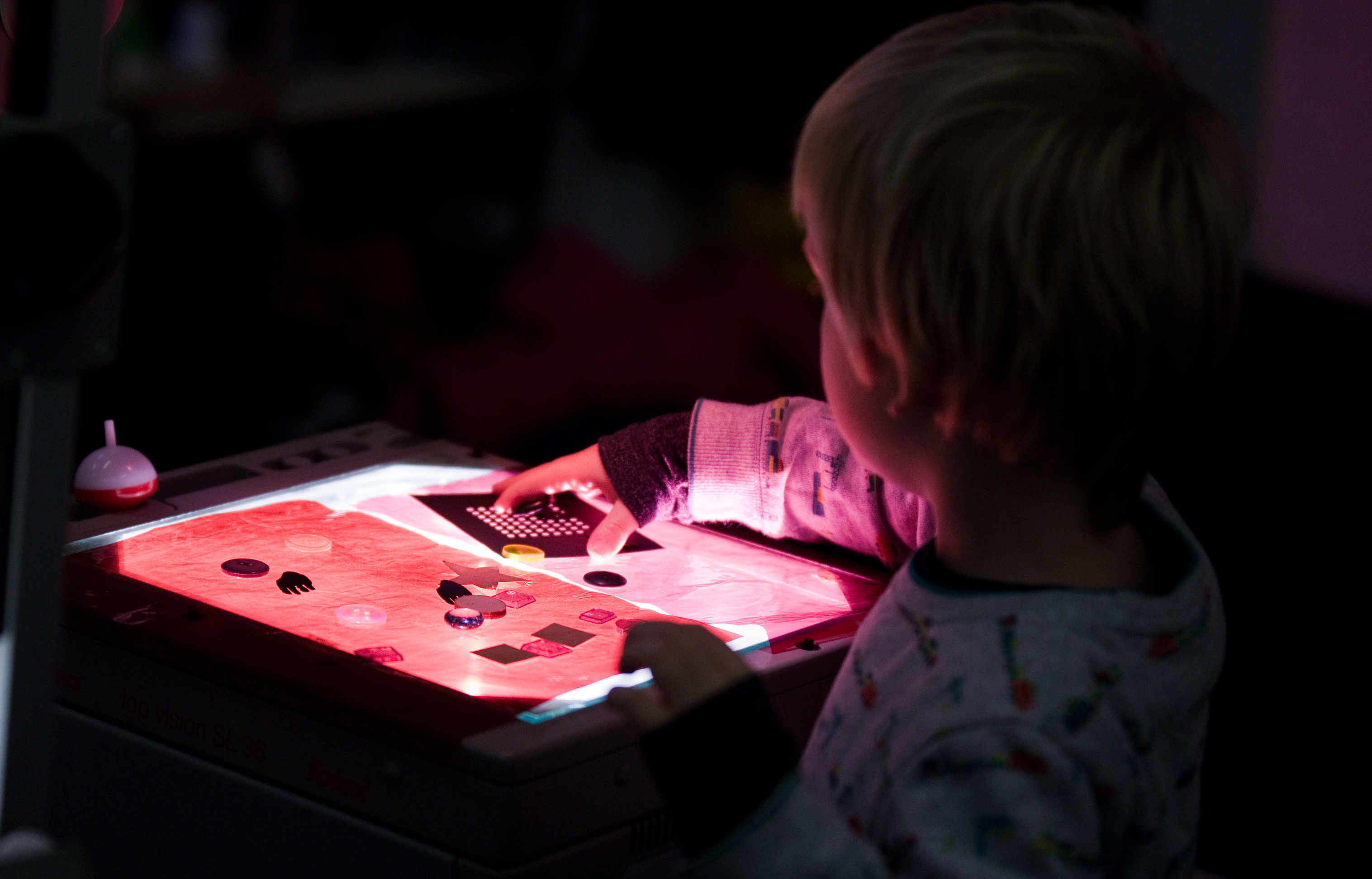
The project developed learning across all areas of the EYFS, in particular:
Characteristics of Effective Learning
Children were observed:
- having a go, persevering and showing resilience
- developing their own ideas and choosing ways to complete activities
- exploring, making links and problem-solving
- being engaged and concentrating
- enjoying achieving what they set out to do.
Personal, Social and Emotional Development
The children grew in confidence, particularly when:
- saying if they did or did not need help, and asking adults for help
- seeking out others to share experiences and initiate conversations
- talking about their ideas, knowledge and understanding
- explaining why they liked some activities more than others
- talking to unfamiliar people or in new social situations.
The children also: - welcomed and valued praise for what they had done
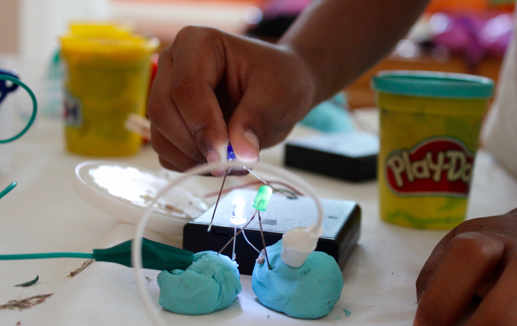
- enjoyed responsibility of carrying out small tasks
- began to take account of others, both in conversations and in taking turns to share resources
- could usually tolerate delay when their needs were not met immediately, and understood their wishes may not always be met.
Physical development
Generally, the children handled tools, objects, construction and malleable materials safely and with increasing control, while some began to use a tripod grip to hold writing tools.
Understanding the World
The children:
- talked about what they had observed, such as plants, animals, natural and found objects
- discussed why things happen and how things work
- looked closely at similarities, differences, patterns and change
- understood that information could be retrieved from computers
- completed a simple computer program
- began to understand ‘why’ and ‘how’ questions.
Communication and Language
The children:
- learnt and were able to use new words rapidly
- used simple sentences and began to use more complex sentences to link their thoughts
- could retell a simple past event in correct order.
Expressive Arts and Design
The children:
- created simple representations of events, people and objects
- experimented with blocks, colours and marks
- understood that tools can be used for a purpose and that different media can be combined to create new effects
- constructed with purpose in mind, using a variety of materials
- selected appropriate tools and resources and adapted their work and techniques necessary
- sometimes gave meaning to marks they had drawn or painted.
Practitioner comments
Practitioners found the activities:
- provided instant gratification for the children, as they observed cause and effect
- were much more inclusive, with more children keen and able to participate
- less adult intensive
- provided an interesting insight into the child’s view of the world
- delighted the children, who made ‘Oos’ and ‘Aars’ as they saw the film clips.
MORE INFORMATION
- https://makeyproject.eu/projects/uk-sheffield/early-years-settings-and-schools
- https://makeyproject.eu/wp-content/uploads/2019/02/MakEY-Guidance-and-Resources-SCHOOLS-web.pdf
- https://apps.apple.com/us/app/pablo/id1114954184
- www.doink.com
- www.createeducation.com
- www.tinkercad.com
- https://int.make.do
- ‘Makerspaces for learning: STEM/STEAM in the early years’, a conference organised by the University of Sheffield in collaboration with Early Education and STEM Learning UK, will be held in London on 9 November. To find out more, see: www.early-education.org.uk/makerspaces-for-learning









